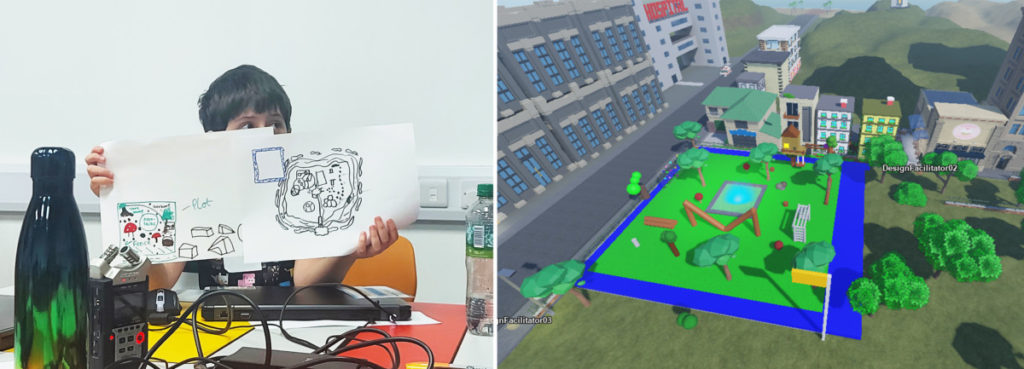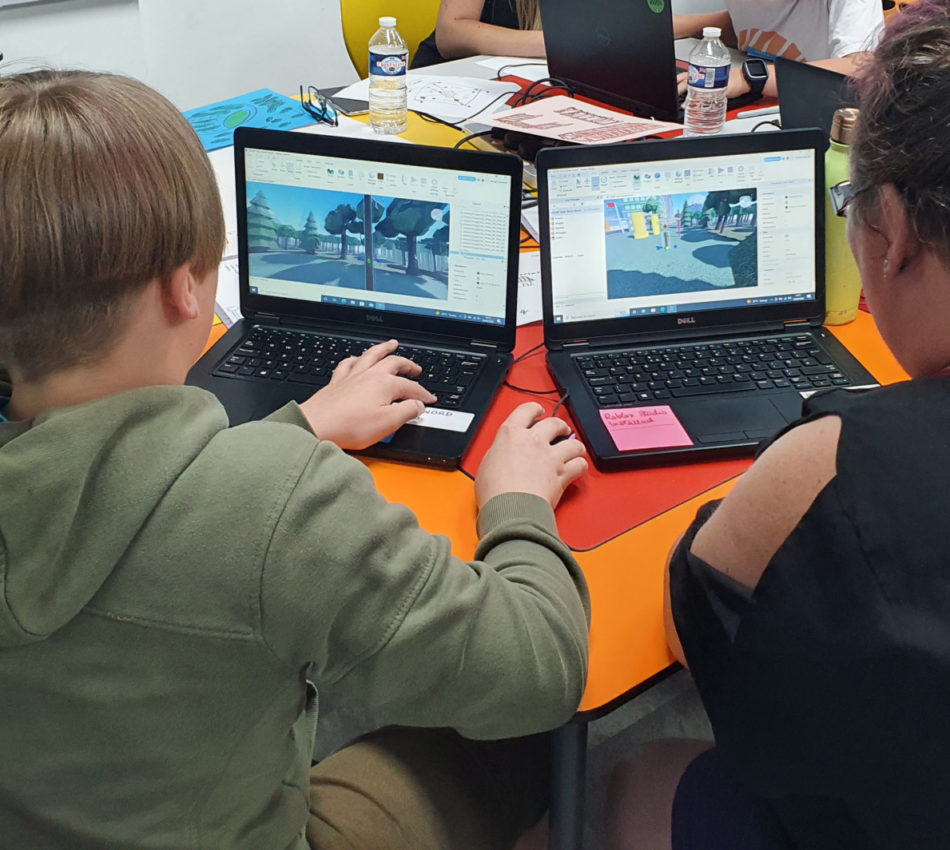Written by:
On 12 August, we teamed up with the National Videogame Museum in Sheffield to offer our State of Play workshop to local families. This workshop was designed and co-facilitated with our summer interns Vince and Enrico from The University of Sheffield’s Transforming and Activating Places (TAP) programme, and our young collaborator Dexter (aged 14). The workshop built on our approach to using gaming as a design engagement tool for children, and marked the first time we had taken the workshop outside the school environment and invited parents in as participants and co-designers. We were joined by 12 children aged 10 and 11 and by their accompanying parents and guardians.
About the workshop
The State of Play workshop was a space to empower both children and adults to experiment with designing spaces for play using the online multiplayer building game, Roblox Studio, and to work collaboratively across generations to co-design playful environments.
Roblox is a multi-user gaming platform that allows users to play thousands of games programmed by other users. Roblox Studio allows users to design and build their own playable worlds within a safe and controlled environment. For the workshop we utilised Roblox Studio to allow the children (and adults) to explore play and design in a digital environment.

Exploring design and designing for play
We started the workshop by introducing the participants to principles of design, explaining that good design brings together the three important principles of form, feeling and function. Design is all around us, from our phones, to our clothes and even our gaming consoles. Talking through a series of examples helped both the children and adults build a shared language for understanding how these principles are interlinked and how objects, spaces and places are shaped by these three pillars of design thinking.
Following this introduction, our TAP interns took the participants on a global virtual tour through some playable landscapes and places, looking at ‘playable’ public spaces, more traditional playgrounds and nature’s playable landscapes. This tour served to inspire the room, embed design principles through the lens of play and think about the diversity of landscapes we can play with, in and on.

Exploring Roblox tools and ideas of play
After a short introduction to design and ‘play spaces’, Dexter, our young collaborator, shared some models he had created within Roblox Studio to inspire the children about the possibilities of the software. He also spoke about his own journey of discovery in Roblox and his journey as co-designer and co-facilitator of the three iterations of the gaming workshop model.
The children then dived into Roblox Studio for a short introduction into the basic building tools and controls, led by our TAP interns, Vince and Enrico. We then set the children off on their individual design task, to build their ideal play space so that children could become more familiar with the Roblox Studio tools and environment. While the children dived into Roblox Studio, the accompanying adults were tasked with looking back on how and where they played as children and recreating their own play spaces using crafts and materials.

Bringing together the memories and nostalgia of the adults’ past play spaces and the childrens imagined play spaces we had a collective discussion on the various models and drawings of each group. The adults mostly reminisced about their time spent playing outdoors, using the city, park, or woodlands as informal spaces of play. Some also talked about the element of risk in some of their play, whether in formal play spaces such as adventure playgrounds or on building sites, in the street or using a whole village as a playable space.
The children imagined various types of play spaces, some experimenting with traditional forms of play equipment, others playing with more abstract ideas, such as making anthropomorphic play structures or obstacle courses. Each child was very playful and experimental with their choice of materiality and colours, adding a layer of complexity to their models which showed a consideration for the three principles of design, form, feeling and function.

Playing together through Co-design
In the afternoon, we brought the children and adults together into four different groups, asking them to work together to draw on the experiences and ideas of both adults and children to co-design, and build a playable place or landscape.
We then gave the groups some time to explore the playable world that Enrico and Vince had designed for the workshop, which had four different locations where the groups could design and build their playable environments. Each space gave a different context to catalyse and imagine different playable landscapes; forest, city park, beach and roof-top.
After an initial exploration of the Roblox world, each group moved into a team planning session to think about how they wanted to co–design their area, what elements it might include and how they would work together to build it. Each child in the group had their own laptop as champions of Roblox inviting their parents into the playable world of design. We also had spare laptops available for adults to have a bash, and while some did dive in, others were happy to share laptops with the children.

There was a wonderful synergy in the output of each playable landscape between the group’s learning, team planning and overall design journey. In all the landscapes, there was a clear influence of each individual in the group, with each child and adult contributing to the collective design. They also combined the memories and nostalgia of their parents’ childhood places and embodied them within these new co-designed playable landscapes. It was a joy to see the cooperation within each group, as each of them stepped into the space of co-design with a spirit of generosity, kindness and reciprocity.
It was also clear to see how the design decisions of each group was a reflection of the context in which each playable plot was positioned and how each of them continued to think about the three core design principles.
The playable landscape at the beach was intimately linked to the ocean, offering playful moments of interaction with the sea. Though at some distance from the water, this was all about getting people into it.
The playable landscape in the forest built playable tree houses for views through, over and into the forest. They used predominantly natural building materials, building abstract play structures, some that sat more naturally against the landscape, others that sat in contrast.
The rooftop playground celebrated the height of their position, creating colourful rooftop creatures, viewing platforms and a bouncy castle. It also played with the notion of risk, enhanced by the position of their plot.
The city park plot introduced more natural elements, such as trees and surrounding rivers to complement its position in the metropolis, as well as re-imagining some conventional park structures such as ponds, climbing frames and walls.
A day of playing and learning together
Overall, the workshop was a joyful day of design, reciprocity and learning. We were all impressed by how the children remained mindful and kind with one another, and by their spirit of collaboration across generations and families. Throughout the day, the children continued to reflect and think critically about the design principles and their application throughout their Roblox co-design build. And the all-embracing imagination and creativity of everyone who joined us for the workshop was an absolute delight.

Thank you to all those who attended the workshop, Vince and Enrico for iterating and co-designing this new gaming workshop model with us and our young collaborator Dexter for his ongoing collaboration on this approach. Finally a big thank you to our partners, The National Videogame Museum who kindly hosted and provided the IT for our workshop.
[Parent – What did you enjoy most about the workshop?] Seeing how young people co-operated on completed tasks with a democratic and kind attitude
[Parent/Guardian] Design is a powerful tool for all ages. Children are already designing programs that some adults have never used. It is quite advanced!
[Young person] I really liked the team building because you could see the different views from people
[Young person] I learnt how to build/work well with others
Transforming and Activating Places (TAP) aims to partner students with organisations and businesses across the UK that focus on place and/or placemaking. Learn more about the programme here.
The National Videogame Museum is committed to using video games as a way to inspire communities, champion collaboration and transform lives. Read more about their work and find out what’s on here.
Dexter began his collaboration with The Glass-House team aged 10, co-designing the original workshop and helping to test new elements that we have added across the workshops. He has helped facilitate all of our gaming workshops to date.

